Tower crane market booms in 2024
17 May 2024
Tower cranes continue to dominate the skyline of all major cities and new products are continuing to proliferate. Niamh Marriott reports.
One the back of recent strong demand, several new tower cranes have already been launched to the market in the first quarter of 2024.
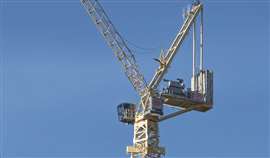 Jaso offers its new luffer for the US and Canadian markets. (Photo: Jaso)
Jaso offers its new luffer for the US and Canadian markets. (Photo: Jaso)
We reported at the end of 2023 that manufacturer Jaso would be unveiling a new tower crane for the USA, Canada and Eastern Territories (Asia and Oceania) markets. Jaso said its new luffer would feature an exceptional freestanding height capability, streamlined for international transport (everything fits in high-cube containers), and that it would boast impressive load charts and tip load.
That new model, the J638PA, has now been launched on the market. It has Jaso Optimus Line technology, which the company says represents a leap forward in crane design and functionality.
A spokesperson for the company says, “This advanced technology ensures optimal performance, efficiency, and safety, making it an indispensable asset for construction projects of all scales.”
The crane was developed in collaboration with its design partners and offers a maximum reach of 65 metres, providing construction teams with greater flexibility and access to heights. It lifts 29 tonnes and offers a maximum tip load of 7.1 tonnes at full reach.
Development and design
As previously reported, a new 32 tonne luffing jib tower crane with moving counterweight has been launched by Potain for heavy modular construction applications.
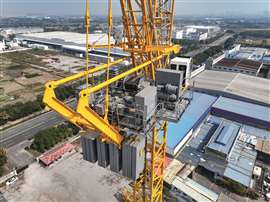 The Potain MCR 625’s moving counterweight design helps get more performance into a smaller package. (Photo: Manitowoc)
The Potain MCR 625’s moving counterweight design helps get more performance into a smaller package. (Photo: Manitowoc)
The MCR 625 is a heavy duty model for Asia, Australasia, the Middle East and Latin America. Built at the Zhangjiagang factory in China, it is for non-CE markets. The design is new, with a moving counterweight, like its MR 618 counterpart for the European and North American markets.
“We are excited to introduce the Potain MCR 625, a crane that offers the perfect balance in power, precision, and compactness. By leveraging the proven design of the MR 618 and adding design elements for fast-emerging global markets, we are empowering contractors to tackle ambitious projects in urban environments with unprecedented efficiency and reliability,” says Leong Kwong-Joon, regional product manager for Potain tower cranes.
Maximum boom length is 65 metres, at the end of which it will lift a maximum of 6.4 tonnes. Booms can be 30 or 40 metres and then increased in 5 metre increments.
The manufacturer has not stopped there, and even more recently, launched two new smaller luffing jib crane models, the MR 309 and MR 329, which come in 16 and 25 tonne capacity variants.
These new models follow the successful introduction of the MR 229 at the Bauma 2022 trade show, which was the first Potain luffing jib crane with the Potain Crane Control System (CCS) and Potain Connect telematics. These new models also have these features.
While both cranes share a 60 metre jib and 3.4 tonne capacity at the tip, they have different load curves and heights under pivot thanks to the respective 2 metre and 2.45 metre pivot and mast configurations.
The company says this latest generation arose from customer feedback for simpler and quicker erection, a greater height under pivot, more powerful load charts, and a smaller out of service radius (minimum 9.5 metres up to 12 metres).
The jib on the MR 309 and MR 329 can be mounted horizontally, section by section, while the reduced windvane spans make installation on tight jobsites easier, Potain says.
Liebherr launch
Manufacturer Liebherr’s latest is the 195 HC-LH 6/12. First shown at the Bauma exhibition in 2022, it will soon be ready to ship to customers.
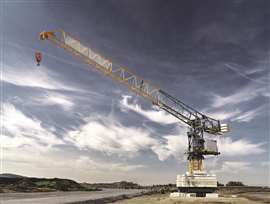 Liebherr’s latest tower crane 195 HC-LH 6/12 is ready to ship to customers. (Photo: Liebherr)
Liebherr’s latest tower crane 195 HC-LH 6/12 is ready to ship to customers. (Photo: Liebherr)
The crane can hoist up to 2.55 tonnes at the jib head at its maximum radius. The hydraulic luffing jib crane achieves these values when combined with the climbable 16 EC tower system with dimensions of 1.6 by 1.6 metres. The crane has a very small footprint and can be transported easily to the jobsite.
In addition, the hydraulic luffing jib crane was designed to be easy to erect. The very small out-of-operation setting and the facility to control it using the popular Litronic assistance systems such as Micromove, the operating-range limiting system and level luffing are state of the art, Liebherr says.
New control
Construction equipment manufacturer Terex will soon launch a new version of a city class flat top tower crane to the market.
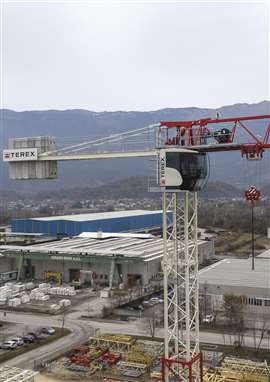 Terex’s new model will have two winch options. (Photo: Terex)
Terex’s new model will have two winch options. (Photo: Terex)
The CTT 152-6 is a 6 tonne capacity crane. Its jib lengths range from 25 to a maximum of 60 metres to better adapt to different job sites and it has a freestanding height of up to 61.2 metres. The crane’s tip load is 1.7 tonnes, or 1.91 tonnes with Terex Power Plus. Terex Power Plus boosts operating capacity by an extra 10 per cent, the manufacturer says.
It features an easy set up and is provided with a S-Pace cabin with an ABB control system and it is compliant with the tower crane safety standard EN 14439-Rev1. The crane features the latest Terex technologies, including T-Torque slewing, which the company says will improve efficiency in daily lifting operations.
The new model will have two winch options (18 or 22 kW) to satisfy the different needs of the market and there are new design improvements such as a pinned connection between the jib and slewing unit, and the removal of counter jib ballast to simplify and speed up installation.
Saudi surge
There are so many areas across the world that are seeing a rise in construction projects, most notably in the Middle East, and in particular in the Kingdom Saudi Arabia. This means more tower cranes are needed on a range of sites.
Saudi Arabia is undergoing transformation at breakneck speed, as the Kingdom aims to reduce its dependence on oil and diversify its economy to incorporate public services and tourism under its Vision 2030 project.
 A rendering of The Line, Saudi Arabia’s plans for a linear city. (Image courtesy of NEOM)
A rendering of The Line, Saudi Arabia’s plans for a linear city. (Image courtesy of NEOM)
While headline-grabbing projects like the 170 kilometre linear city, The Line, garner huge amounts of publicity, elsewhere in the country, there is a wide array of other ambitious projects worth many billions of dollars, presenting opportunities for architecture, engineering and construction companies all over the world.
Building boom
In response to the new construction landscape in the Kingdom of Saudi Arabia, manufacturer and rental company Wolffkran has established a new venture business, based in the Saudi capital Riyadh, to provide rental solutions and services throughout the region.
The venture is being led by experienced mechanical engineer Tariq Al-Sawaie and has already tendered projects for a fleet of 90 tower cranes, with many other tenders in progress.
Wolffkran says that the timing of this venture strategically aligns with the Saudi Arabia’s ongoing building boom, which the company says is marked by an impressive US$ 56 billion-worth of projects in the pipeline. It says that its projections indicate this figure will surge above US$ 90 billion by 2029.
Surgical precision
Wolffkran has been working in other areas too, including in Europe. On one recent job it diagnosed and prescribed solutions for a series of challenges on a hospital construction project in Germany.
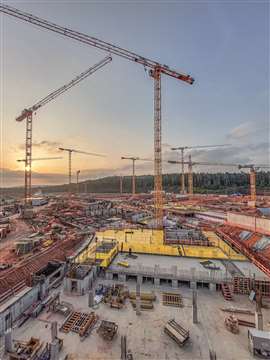 A total of 13 Wolff tower cranes are helping to build the new 4,000 room hospital in Germany. (Photo: Wolffkran)
A total of 13 Wolff tower cranes are helping to build the new 4,000 room hospital in Germany. (Photo: Wolffkran)
Military and other parameters added up to a multiplicity of requirements on the 13 crane site. The project is to construct what will be the largest US military hospital outside the USA. Being built close to the Ramstein air base near Kaiserslautern, it will replace the US Army hospital built in 1953 in nearby Landstuhl.
The new hospital will have more than 4,000 rooms including nine operating theatres. It is being built by ARGE US-Klinikum Weilerbach, a construction consortium consisting of Ed. Züblin AG and Gilbane.
“Even before the crane foundations could be planned, numerous bureaucratic hurdles had to be overcome,” says work planner Daniel Rüttinger, responsible for process planning and construction operations at Ed. Züblin.
Aerial interference
With the project sitting directly on the flight path of Ramstein Airbase the site, plus mobile cranes there, the company needed aviation permits from the German Armed Forces Aviation Office. Special lighting also had to be fitted.
Ground conditions presented another challenge. “Due to the highly heterogeneous subsoil, consisting of several soil layers, exploratory drilling was carried out at each crane site,” explains Daniel Rüttinger.
Buoyancy created by rising groundwater and underground pipes had to be factored into the foundation design. A further consideration was the compatibility of the concrete for the foundations with naturally occurring radon in the ground.
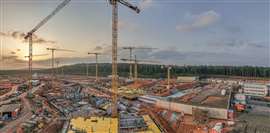 Aviation permits were required for the Wolffkran cranes as the German site sits in the flightpath of the Ramstein airbase. (Photo: Wolffkran)
Aviation permits were required for the Wolffkran cranes as the German site sits in the flightpath of the Ramstein airbase. (Photo: Wolffkran)
To give the cranes full coverage of the site some of them had to be positioned low in the ground. These had foundations up to 2.4 metres high and shoring around the lower tower sections so the tower could be completely removed at the end of the job.
Spanish pair
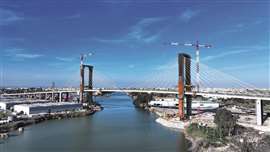 Seville-based tower crane rental specialist Sancho Toro Sur provided the two Liebherr 420 EC-H 16 Litronic tower cranes for the bridge project. (Photo: Liebherr)
Seville-based tower crane rental specialist Sancho Toro Sur provided the two Liebherr 420 EC-H 16 Litronic tower cranes for the bridge project. (Photo: Liebherr)
Seville-based tower crane rental specialist Sancho Toro Sur provided the two Liebherr 420 EC-H 16 Litronic tower cranes for the bridge project
In Spain, a pair of Liebherr 420 EC-H 16 Litronic conventional saddle jib tower cranes were chosen for the lifting work on a project to renovate and upgrade a road bridge, the Puente Quinto Centenario.
A lifting height of 110 metres was one of the requirements. Challenges included the design and implementation of securely mounting the cranes to the bridge pylons.
The three lane bridge spans the Gualdalquivir River in Seville and another lane is being added as part of the refurbishment project. It will mean two lanes of traffic in each direction to help ease congestion.
The tower cranes on opposite banks of the river are each tied to the pylons using two struts. These struts are welded up from 500 mm box section steel. They have to reach through the stay cables to the bridge pylons and must not have contact with the cable stays which was a challenge to implement.
In designing and implementing the scheme, crane owner Sancho Toro Sur was supported by the Liebherr Tower Crane Solutions (TCS) project department. The tower cranes were installed and erected to their final height using a mobile crane, without needing any subsequent climbing or jumping to raise the height.
Installing the ties was done first, followed by the slewing sections of the cranes. Safety was especially important as the bridge remained open during crane assembly.
Loads lifted by the cranes, to a height of 110 metres, include pylon reinforcements weighing 7.5 tonnes. Ten of these parts are needed to add the extra lane to the bridge. The refurbishment part of the job includes replacing all 80 of the cables on the bridge that is only just over 30 years old.
Israel Requena, Sancho Toro Sur managing director, says, “The work is a challenge for us and we’re happy to be involved in this important project. The two Liebherr cranes are ideal for this job with their maximum hook height of 87.10 metres, 16 tonne lifting capacity and radius of up to 75 metres. Their efficiency, agility and reliability make them the perfect choice for renovating the Puente Quinto Centenario.”
Luffers in Toronto
 The wide swing angles of the LR273 allow for greater site coverage, Raimondi says. (Photo: Raimondi)
The wide swing angles of the LR273 allow for greater site coverage, Raimondi says. (Photo: Raimondi)
Canadian company Avenue Building Corporation has deployed two Raimondi LR273 luffing jib cranes for the construction of The United Bldg, described as an historic landmark development in Toronto, Canada. EllisDon is the main contractor for the project.
Installed between December 2023 and January 2024, the two 18 tonne capacity luffing jib tower cranes are on site at a height of 60 and 54 metres with jib lengths of 45 and 50 metres, respectively, and a tip load of 4.5 tonnes.
Equipped with an 86 kW hoisting gear, the LR273s lift at a maximum speed of 204 metres per minute and have a drum capacity of 980 metres.
Scheduled to be onsite for several years with varying timelines, the cranes will be internally climbed to reach final heights of 65 and 195 metres, respectively.





